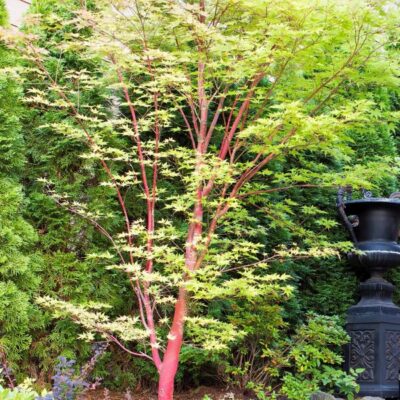Garden Plant: Coral Bark Japanese Maple
Product Description: Coral Bark Japanese Maple

Showy, Fiery, Versatile Coral Bark Japanese Maple
- Vibrant, Coral-Red Bark on Young Stems
- Four Seasons of Interest
- Attractive, Finely Dissected Foliage with Reddish Leaf Margins
- Smaller in Stature and Very Versatile
- Easy to Grow
- Hardy Across a Wide Range of Zones
If you need a brilliant accent in your landscape, you need a Coral Bark Japanese Maple (Acer palmatum \’Sango Kaku’). You’ll love it every time you step into your yard.
Who doesn’t love Japanese Maple trees? This is an incredible variety with beautifully ornamental features. A small tree, Coral Bark Japanese Maple offers an outstanding display and so much character.
It just takes one glance to understand how the Coral Bark Japanese Maple earned its name. It’s widely admired for its bright red bark. The intense reds turn up the volume to a fierier pitch as the temperatures plummet for the winter months.
The winter bark of the younger thinner branches exhibit an electric, fluorescent, coral color. It might literally knock your socks off!
This red character comes from showy red sap flowing inside the tree, which gives that amazing color of the bright red bark. The sap also displays on the elegant foliage in spring and summer.
Lovely grass green leaves are dissected with seven deep palmate lobes. As you might imagine, the color almost glows against the red bark. And the characteristic sap displays as a reddish margin through spring and summer.
Strikingly intricate leaves provide a lovely, dappled shade. But this four-season stunner features vibrant hues all year. In fall, the leaves turn a beautifully luminous, rich golden-orange.
It’s in winter when its leaves fall away in winter, that this tree truly shines. You’ll never tire of admiring the crimson branches of the winter bark.
This impressive tree attracts a lot of attention, but is easy-care when given the right growing conditions. This graceful maple will delight you season after season, year after year.
Order today, as we quickly sell out of this selection.
How to Use Coral Bark Japanese Maple in the Landscape
Use this small tree somewhere it can be viewed up close and personal. Don’t forget to add outdoor lighting to your design plans. Try uplighting Coral Bark Japanese Maple at night. You’ll create welcome summertime drama and highlight the fantastic winter color, too.
If you want to show off your Coral Bark Japanese Maple, you can plant it near your entryway as a magnificent specimen. Add a burst of red to your woodland garden, or near your patio, with several of these easy-to-manage beauties.
Coral Bark Japanese Maples make a great focal point in a Garden Room or backyard planting. Create a small group with several trees to screen out imposing neighbors or unsightly views. Keep the lower branches on in a privacy application.
You can also use a group of three plants in a wide, sweeping berm.
Use it as a specimen tree, or as an anchor at the corner of a foundation planting. It’s easy to tuck these into out-of-the-way spots in your yard to create a delightful destination feature at the end of a dramatic, winding garden path.
Of course, it can become a focal point in a Japanese Garden. Or, use it to give shade and a beautiful object to study in a modern Meditation Garden.
Try them in very large containers as a versatile accent, just about anywhere in the landscape. Why not command attention immediately with one placed on either side flanking an entryway? Enjoy setting your stage with gorgeous Coral Bark Japanese Maples. You can’t go wrong!
Pro Plant Tips for Care
Plant Coral Bark Japanese Maple in partial sun to full sun. It performs best in moist, slightly acidic, mulched, well-drained soil.
Coral Bark Maple appreciates some shade from hot afternoon sun in the warmer climates. Give it a protected site out of the worst of the wind in colder climates if you can.
Give Coral Bark Maple a moderate amount of regular water. Make sure you include a thick mulch over the top of the roots to help keep the roots evenly moist and a bit cooler. As with all plants, pull back the mulch from around the trunk of the tree by an inch or two.
Prune late winter when dormant, before it begins to grow for the season. Like most woody plants, it’s a good idea to thin out the inside of the canopy for better sunlight and air circulation.
Study the tree before you start. Decide which branches You’ll keep, in order to give it a bit of character. Maybe you will like keeping the lowest branches on the tree, so don’t be in a hurry to remove them. Take your time when pruning!
This magnificent small tree sells out very quickly. Sign up to receive an email notification if we’re out of stock. Place your order now if we have it in inventory.


